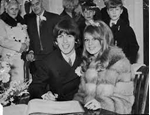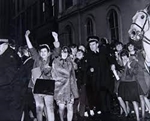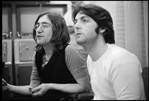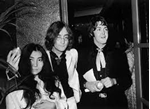- Register
- Log in to Tune-In
- Wishlist (0)
-
Shopping cart
(0)
You have no items in your shopping cart.
Beatles News

Paul McCartney is set to appear at a livestream event on Nov. 5 in which he'll discuss his new book, The Lyrics: 1956 to the Present.
The music legend will chat with author Paul Muldoon about The Lyrics, which includes anecdotes and personal history spanning McCartney's entire career - including his time with the Beatles and Wings, and his solo work.
A statement on the event's website reads: "Arranged alphabetically to provide a kaleidoscopic rather than chronological account, [The Lyrics] establishes definitive texts of the songs’ lyrics for the first time, and describes the circumstances in which they were written, the people and places that inspired them, and what he thinks of them now."
The Lyrics: 1956 to the Present is due for release on Nov. 2, a few days before the livestream event.
“More often than I can count, I’ve been asked if I would write an autobiography, but the time has never been right," McCartney said in a statement earlier this year.
Source: ultimateclassicrock.com
details
George Harrison has given us some of the most inspiring songs in rock ‘n’ roll history. He was the first Beatle to have a No. 1 hit as a solo artist with his song “My Sweet Lord.” However, before and after his time as a Beatle, George had one very special muse for all of his love songs; his wife, Pattie Boyd. George wrote many Beatles hits about Boyd, including the romantic “Something” and “I Need You.” But George only wrote one song about her during his solo career, and it wasn’t a love song.
George met Boyd while The Beatles were filming A Hard Day’s Night in 1964. They married two years later, and Paul McCartney was his best man. During their marriage, Boyd inspired George to write songs like “Something,” “I Need You,” and “For Your Blue.”
However, after George cheated on Boyd multiple times, including having an affair with Ringo’s wife Maureen, the couple’s marriage started to disintegrate around the early 1970s. Speaking with Start at 60, Boyd talked about what the final years of her marriage to George were really like.
Source: cheatsheet.com

For one Times Past reader, there was a surprise in store when his favourite band came to town – and a mystery he has yet to solve.
Phil Quigley explains: “I am 80 years of age and the memories of the Beatles’ visit to Glasgow are still vivid in my mind.
“I was working as a gent’s hairdresser near Charing Cross at the time and during the usual chit chat with one customer, he asked me if I liked the Beatles.”
He adds: “I said, yes, of course and when he took his wallet out to pay, he offered me a ticket for the Glasgow concert, which knocked me out.
“He apologised and said he only had one ticket, but I gratefully accepted it. He wouldn’t take any payment for it and said ‘just give the money to charity’, which I did.”
Phil, who lives in Rutherglen, still has no idea who the benevolent gentleman was. He adds: “I was in a daze all day.”
When he got to the concert, the first thing Phil noticed was there were not many men in the audience.
Source: Ann Fotheringham

“Help!” has some of the most famous lyrics John Lennon wrote for any of The Beatles’ folk-rock songs. During an interview, John revealed he wrote the lyrics to please a journalist who noted he didn’t use certain types of words in his songs. John said writing The Beatles’ “Help!” to please this journalist reflected his own insecurities.Paul McCartney told Billboard two people heard “Help!” before the public did. “I turned up at John’s house for a writing session and saw the opportunity to add a descant [melody in the second verse],” Paul said. “We finished it quite quickly; we went downstairs and sang it to John’s wife at the time, Cynthia, and a journalist he was friendly with called Maureen Cleave. We were very pleased with ourselves.”
Source: cheatsheet.com
details
Fifty-seven years ago, Ringo Starr, John Lennon, George Harrison and Paul McCartney performed their one and only Pittsburgh show at the Civic Arena.
Thousands of shrieking teenage girls made more noise than the chartered Lockheed Electra that delivered the Fab Four to Greater Pittsburgh Airport on Monday, Sept. 14, 1964. First off the plane was Ringo Starr, who spoke briefly with KDKA-TV reporter Al McDowell as someone inexplicably tossed tomatoes at the band.
It had been that kind of tour for the Beatles, reported the Pittsburgh Post-Gazette. “Crazy, unpredictable, playful, a hint of anarchy and danger in the air. And flying food. Mostly it was jelly beans, but in Chicago a week earlier, a frozen T-bone steak hurled at the stage nearly clobbered Paul.”
Source: pittsburghmagazine.com
details
A set of previously unheard interview tapes featuring John Lennon speaking about his favourite Beatles songs are to be sold at auction.
Canadian journalist Ken Zeilig recorded the 91 minutes of interviews with the star, and Yoko Ono, on three separate occasions during 1969 and early 1970.
It is believed only five minutes have been aired, in the late 1980s.
Lennon also speaks of his musical influences, the future of The Beatles and how his wife changed his life.
He said he thought the band had "a positive effect" on the youth of the 1960s.
Lennon also recalls a Christmas memory in which he reached into a stocking and found a present of a mouth organ.
"That was one of the greatest moments of life, when I got my first harmonica," he said.
The 12 reel-to-reel tapes contain both edited and unedited interviews, Beatles music and detailed transcripts.
Source: BBC
details
When United Airlines Flight 175 hit the North Tower, Paul McCartney was sitting waiting for his plane to take off at John F. Kennedy Airport. The beatle was a direct witness to the attacks on the World Trade Center and the closure of airspace over a shocked New York.
McCartney was putting the finishing touches on the excellent Driving Rain, which included the single “From a Lover to a Friend”, a song in which he tried to deal with the death of his wife Linda. Instantly, he announced that royalties from the theme would be donated to the families of the dead firefighters in the attack. But he felt the need to do more and help the city that launched The Beatles to stardom in 1964. On September 12 he had ready “Freedom”, a song destined to be chanted by thousands in which raised a flag for social rights and that would become a classic during his 2002 US tour, his first tour since 1993.
Source: thesaxon.org
details
The Beatles recorded their first-ever single, Love Me Do, on September 4, 1962, with the band's first drummer Pete Best playing the percussion instrument. The band's manager, Brian Epstein, and their producer, Martin, decided Best wasn't cut out for the job, so got rid of him. George Harrison, John Lennon and Paul McCartney attempted to replace him with Ringo Starr, but Martin and Epstein had other ideas.
On this day, September 11, in 1962, Ringo arrived at EMI studios to record his first single with The Beatles only to find another drummer in his spot.
Martin once recalled: "On 11th September 1962, we finally got together to make their first record. The boys, meanwhile, had brought along a guy [Starr], and they said: 'We're going to get Ringo to play with us.'"
Source: Callum Crumlish
details
No other band has been examined under a microscope as meticulously as the Beatles. Detailed books have even been written focusing solely on the instruments they played and the gear used to make their recordings in the studio.
But with all this exhaustive research, some details are still unknown. For example, historians may know what instruments were brought to and available for each recording session, but the exact guitars and amps used on many songs still remain purely the subject of speculation.
Although many photos were taken of the Beatles working in the studio, only one video exists of them at work while recording.
On February 11, 1968, the Beatles showed up at Abbey Road Studio Three to shoot footage for a promotional film for Lady Madonna. To make the best use of their time, they decided to record Hey Bulldog while the cameras rolled. As a result, the footage provides a definitive record of the instruments used.
Source: Chris Gill/guitarworld.com
details

The Beatles are considered by many to be the greatest band of all time. Even if someone doesn’t agree with that statement, it is hard to deny the massive influence the Beatles have had on the last five decades of popular music.
During their time together, they released 13 albums, which is even more impressive when you take into account the fact that they were only releasing music for seven years. That isn’t a very long time, considering the duration of other bands. For example, the Rolling Stones have been going strong for nearly 60 years, Elton John for 50 years and the Red Hot Chili Peppers for over 35 years.
Source: Braden Murray/baylorlariat.com
details
It took Paul McCartney a little while to find love again, but he’s found it in Nancy Shevell. The ex-Beatle has been married three times. First to the love of his life, and mother to three of his four children, Linda McCartney. They were bandmates and soulmates until she died in 1998 of breast cancer. Then, to Heather Mills from 2002 to 2008. Now, Shevell, whom Paul married in 2011, is the new Lady McCartney.
Shevell is different. When she met Paul, allegedly through her cousin Barabara Walters, she already had an impressive career and fortune all on her own, so marrying a billionaire rock star didn’t change much. The only challenging thing about being married to an ex-Beatle is having to face the spotlight.
Source:cheatsheet.com
details

A series of previously unheard interviews with John Lennon and Yoko Ono are expected to fetch up to £30,000 when they go under the hammer.
hats with Canadian writer Ken Zeilig from 1969 feature the former Beatle and his wife discussing everything from their love for each other, their Bed-ins for Peace anti-war protests and Lennon’s haircut.
The tapes were discovered by the family of interviewer Zeilig and they will be sold at an Omega Auctions event later this month.
Of their bond, he said: “That’s our only worry in the world, is that we die together. At exactly the same minute, otherwise, even if it’s three minutes later, it’s gonna be hell. I couldn’t bear three minutes of it.”
Lennon, who was still a Beatle at the time of the recording, discussed the band’s future.
They broke up in 1970.
Asked what plans The Beatles had, Lennon said: “They don’t, you know. The Beatles never made plans after they stopped touring.
“Plans were always made for them. And once there was nobody making plans for us, we didn’t want any plans, so we don’t make them.”
Source: Keiran Southern/independe details

Linda’s debut duet with Paul McCartney was a sad farewell to The Beatles.
Around the time The Beatles broke up in 1970, PAUL MCCARTNEY recorded a solo album. The album included a song that served as a touching farewell to his time in the band with which he had grown up, and featured his wife for the first time.
After concluding the writing and production of their final album, Let It Be, the Beatles disbanded in 1970. After 10 years in a world-famous band that sold millions of records and toured the globe, John Lennon, Paul McCartney, Ringo Starr, and George Harrison all parted ways. In April 1970, one month before the release of Let It Be in May 1970, McCartney produced his first solo album, which included an homage to his old band, Man We Were Lonely.
The song was recorded right before the final touches were applied to Let It Be.
Source: Helena Sutan/en.brinkwire.com
details
Paul McCartney is one of the best songwriters in the music industry. He was the other half of The Beatles songwriting duo Lennon-McCartney, which gave fans songs like “Hey Jude” and “Yesterday.” In his solo career, Paul gifted us with hits like “Band on the Run” and “Maybe I’m Amazed.” However, while each McCartney song comes with its own interesting back story, one song doesn’t exactly bring up good memories.
Going into 1970, The Beatles were not on good terms with each other. Ultimately, many factors contributed to the band’s demise after being together for most of the 1960s.
Things started going downhill when their manager Brian Epstein unexpectantly died in 1967. Then the band started to feel that Paul was controlling everything, John Lennon was bringing Yoko Ono to the studio, and each of the members thought the band would be better if they left. Tensions mounted while they were filming Let It Be. Eventually, John told the group he was leaving, and Paul announced he quit in April 1970, which started a media frenzy. The rest of the band quickly started their own solo careers, but Paul had already recorded his first solo album.
Source: details

At the close of the 1960s, a decade that witnessed a generation explore the expansion of one’s consciousness through the opened doors of perception and a subsequent rise in religious awareness, George Harrison was in the midst of his own personal awakenings.
Life in The Beatles had lost its luster during the making of The White Album in 1968, as his songwriting contributions continued to be unjustly stifled by the group’s dominant Lennon/McCartney partnership, who still viewed him more as a guitarist and secondary vocalist than an author of merit. “As a singer, we allowed him only one track on each album,” John Lennon later admitted. “The songs he and Ringo sang at first were the songs that used to be part of my repertoire in the dance halls. I used to pick songs for them from my repertoire… the easier ones to sing.”
Source: Simon Harper/udiscovermusic.com
details